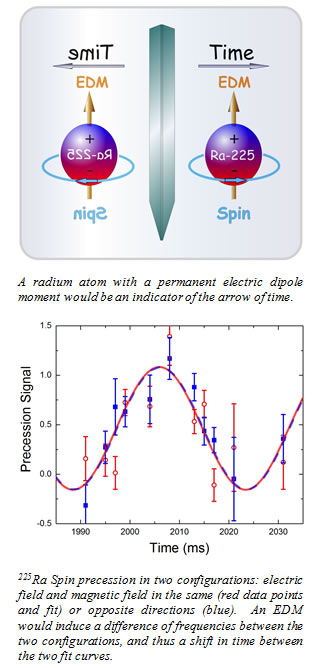Testing Time-Reversal Symmetry Using Ultra-cold Radium Atoms
New laser trapping methods for the search of an atomic EDM have been demonstrated with a first measurement on radium-225. Scientists have long been searching for a permanent electric dipole moment (EDM) in atoms and particles, a property forbidden by the fundamental symmetries of space and time (see upper figure). Physical effects that violate these symmetries are needed to explain the dominance of matter over antimatter in the Universe, and may induce an EDM observable in the laboratory. In particular, the EDM of radium-225 is predicted to be greatly enhanced by its unusual pear-shaped nucleus. For this measurement, the atoms are held by an optical trap formed at a focal point of a laser beam. The spins of these trapped atoms are then studied to look for any changes due to an external electric field (see lower figure).
The reported first measurement has yielded a null result – The EDM of radium-225 is found to be smaller than 5 x 10-22 e-cm. Future searches at higher sensitivity levels are being planned. Researchers are developing ways to capture more atoms, to keep atoms in the trap for longer times, and to more efficiently detect the spins. These improvements are expected to increase the sensitivity of the measurement by a factor of 1000 or more over the next few years. The radioactive radium-225 is produced by the Department of Energy’s Isotope Program for cancer treatments as well as for this physics study. In the future, the FRIB accelerator currently under construction in Michigan can deliver 100 times more radium-225. With this, a further improvement in the sensitivity of the measurement is achievable with the goal of ultimately reaching at least 10-28 e-cm.
Reference
-
First Measurement of the Atomic Electric Dipole Moment of 225Ra, R. H. Parker, et al., Physical Review Letters 114, 233002 (2015)
![[Argonne Logo]](/images/argonne_header_logo.jpg)
![[DOE Logo]](/images/header_doe.gif)
